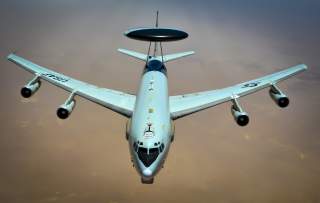Air Force Deploys ‘Bird Cannon’ In Opening Salvo Of Global War On Geese
Bird strikes are a real problem.
The security forces at U.S. Air Force installations face some truly scary challenges, from vehicular intruders on the flight line to misplaced grenade and machine gun rounds.
But there’s one threat that’s both difficult to anticipate and near-impossible to thwart: birds.
We’re deadly serious. Bird strikes on U.S. military aircraft destroyed 27 U.S. Air Force airframes and left 36 airmen dead between 1985 and 2016, according to data compiled by the 28th Bomb Wing at Ellsworth Air Force Base. As recently as 2016, a flock of birds helped contribute to the disastrous aborted takeoff of a B-52H Stratofortress bomber at Andersen Air Force Base in Guam.
Alfred Hitchcock was right: those damn, dirty birds are up to no good.
The Air Force however, has engineered a solution to their winged problem in the form of an “automated bird deterrent system.” That’s right: the Air Force has the bird cannon, and they’re not afraid to use it.
The $150,000 system, recently installed at Ellsworth Air Force Base in South Dakota, consists of a rotating cannon turret and a 20-gallon propane tank. By igniting a small distillation of propane, cannon directs a shot-gun style sound blast that disrupts meddling flocks of birds; newer models feature computer-controlled speakers that cycle between various bird calls.
It may seem like a steep price tag for a relatively simple system: $150,000 is a small price to pay to keep birds away from the flight line.
According to Military Times, the Air Force racked up nearly $182 million in damage to aircraft thanks to more than 400 wildlife-related mishaps between 2011 and 2017.
“Birds are a huge problem for our aircraft operations,” 28th Bomb Wing flight safety officer James McCurdy told the Associated Press.
“In the middle of our migration season (October, November, April and May), it’s not abnormal for us to hit and kill a bird at least once a week. They cost us hundreds of thousands of dollars a year.”
Let this be a warning to the all the adventurous birds out there: Should any fowl ran afoul of base airspace, they’ll only end up getting goosed by the Air Force’s canary cannon. So back off— this ain’t just for the birds.
This article by Jared Keller originally appeared at Task & Purpose. Follow Task & Purpose on Twitter. This article first appeared in 2018.
More Articles from Task & Purpose:
- 7 Veteran-Friendly Manufacturers That Are Hiring
- The 6 Types Of Contractors You Encounter Overseas
- Here’s How Marines Fared On The New Physical Fitness Test
Image: Flickr

